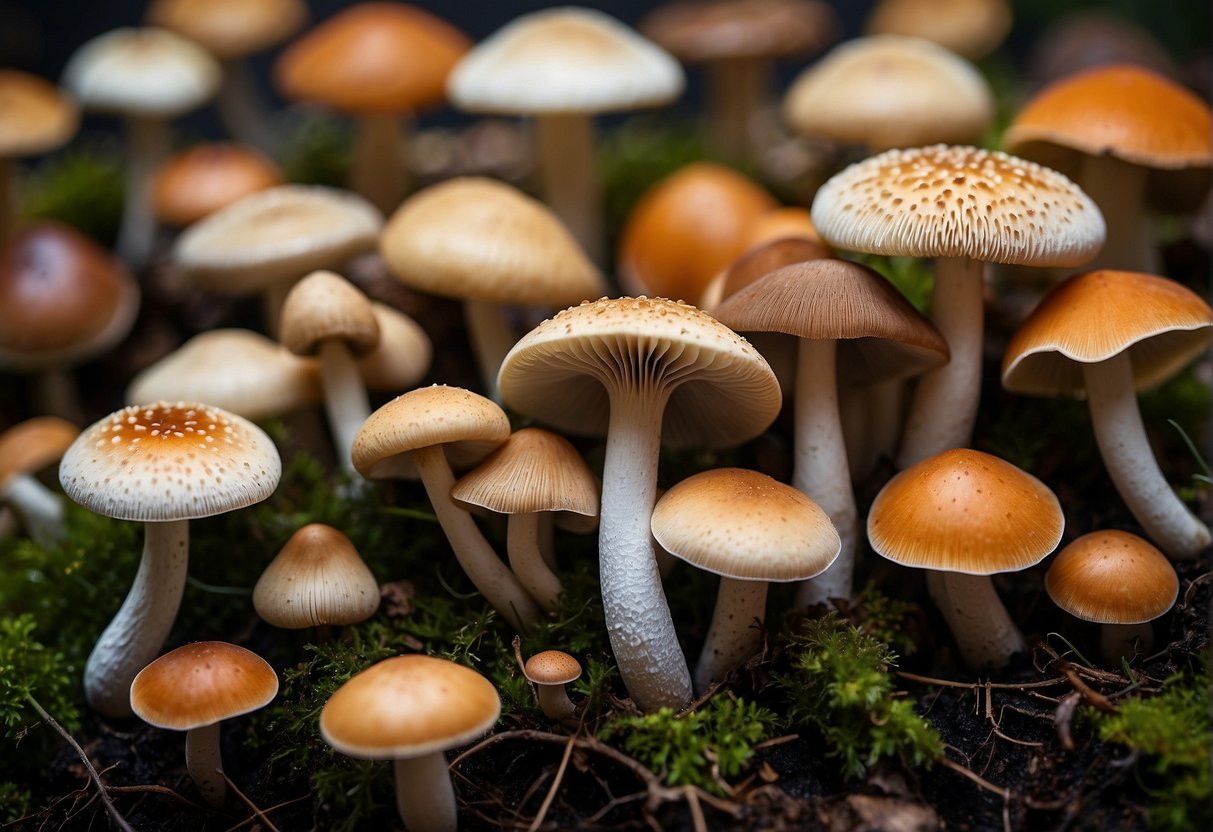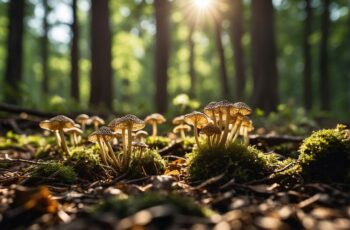Mushroom identification can be an engaging and rewarding part of foraging, appealing to the curious outdoorsman in you. Venturing into the woods with the goal of finding fungi can turn a simple hike into a treasure hunt, especially when you’re equipped with the knowledge to safely distinguish between the vast array of mushrooms. Understanding the basics of mushroom anatomy is the cornerstone of identifying different species; recognizing cap shapes, stem features, gill formations, and spore colors is essential.

When you’re out in the field, the practical techniques for mushroom identification become particularly important. Being able to assess the subtle differences can mean the difference between finding a delicious edible mushroom and a potentially poisonous look-alike. It’s critical to remember that while some mushrooms are a forager’s delight, others can pose serious health risks. Therefore, always forage with caution and use identification charts for informational purposes only, unless you are an experienced mycologist.
Key Takeaways
- Recognizing mushroom anatomy is key to identifying species.
- Accurate identification is crucial for distinguishing edible from poisonous mushrooms.
- Foraging demands caution and should be guided by reliable information and expertise.
Basics of Mushroom Anatomy
Getting to know the key parts of a mushroom will vastly improve your identification skills when you’re out in the wild. The anatomy of a mushroom encompasses several distinct features, each with its own variations that you need to recognize.
Recognizing Different Cap Shapes
The cap, or pileus, of a mushroom is the most recognizable part. It comes in various shapes which can aid in identification:
- Bell-shaped: Often seen in younger mushrooms, this shape can evolve as the mushroom matures.
- Conical: Shaped like a cone, some species retain this shape throughout their lives.
- Flat: Indicates a mature mushroom, as many species’ caps flatten with age.
- Round: Typically found in puffballs and other non-gilled mushrooms.
Remember, the physical characteristics like the color and texture of the cap are also important for identification.
Understanding Gills and Pores
Beneath the cap, you’ll find gills or pores:
- Gills: These are the rib-like structures that radiate out from the mushroom’s stem. They can vary in color and spacing, which is crucial information for identifying gilled mushrooms.
- Pores: Found in pored mushrooms, like boletes, these are small tubes where the spores are released. If the pore layer is soft and easily detached, you’ve likely found a bolete.
Stems and Veils Across Species
The stem, or stipe, supports the cap and can vary wildly in length and thickness:
- Thin and elongated: Common in many mushrooms and serves the purpose of elevating the cap.
- Thick and bulbous: Offers a sturdy base, often found in mushrooms with larger caps.
Some mushrooms also have a veil, which initially covers and protects the gills or pores. Remnants of the veil can often be found on the stem or the cap’s edge. It’s an important feature that shouldn’t be overlooked as it can be a critical identifier.
Mushroom Identification Techniques
Successfully identifying mushrooms is both challenging and rewarding. Your ability to accurately name a species can mean the difference between finding a delicious treat or a lethal mistake. This process relies heavily on observation and comparing those observations against reliable resources.
The Role of Spore Print in Identification
A spore print is crucial for identifying mushrooms. You can obtain a spore print by removing the cap of the mushroom and placing it gill-side down on paper or glass. After a few hours, the spores fall and leave a print. This print, which can range in color from white to black and many shades in between, is a key identifier. Spore color can sometimes be unique to a species and is an essential step to avoid errors in identification.
Habitat as an Identifying Factor
Understanding the habitat where you find a mushroom plays a big role in its identification. Different mushrooms flourish in varied environments—some prefer the dense, moist floor of a forest, while others grow in open grasslands. Observing elements such as the type of trees nearby, soil moisture, and elevation can narrow down potential species significantly, increasing the accuracy of your identification work.
Utilizing Field Guides and Digital Resources
No mushroom identifier is complete without extensive field guides, which provide detailed descriptions and pictures to assist you. Physical books cater to both beginners and experts, and they focus on species from a particular region or of a certain type. On the flip side, digital databases and even YouTube can offer a more interactive approach, supplemented with pictures and sometimes videos. Websites like Ultimate Mushroom Library provide a comprehensive mushroom identification helper. It’s important to use multiple sources to confirm your findings, as this helps to minimize the chance of errors or omissions and understand the implications of identifying lethally poisonous mushrooms incorrectly.
Edibility and Toxicity of Mushrooms
When foraging for mushrooms, your safety hinges on distinguishing between edible mushrooms and those that are poisonous. Understanding the indicators of toxicity and knowing how to properly handle mushrooms for culinary purposes is key to enjoying them without risks of vomiting, diarrhea, or worse, coma.
Spotting Poisonous Varieties
Identifying poisonous mushrooms is crucial to foraging safety. Some poisonous varieties mimic their edible counterparts, so meticulous verification is necessary. Strongly advise against consuming wild mushrooms unless you are completely sure of their identity. For instance, mushrooms with white gills, a skirt or ring on the stem, and a bulbous or sacky base are often telltale signs of the deadly Amanita species. Similarly, red on the mushroom, such as on the cap or stem, should alert you to potential danger.
Tasting and Consumption Safety
Never taste a wild mushroom unless you are certain of its edibility. Some edible mushrooms can be delectable, but confusing them with even slightly toxic ones could lead to serious health problems. Remember, cooking does not always neutralize mushroom toxins. If you wish to integrate edible mushroom varieties into your diet, start by learning from a knowledgeable mycologist or using a reliable mushroom identification chart.
Culinary Uses of Edible Mushrooms
Once you’ve positively identified an edible mushroom, a world of culinary opportunities opens up. Delicious mushrooms like Morels or Chanterelles are sought after for their rich flavors and textures. They can be sautéed, roasted, or incorporated into various dishes for enhanced umami. Always clean them properly and, if in doubt, consult a seasoned forager or educational resources to confirm their edibility before they make their way to your plate.


